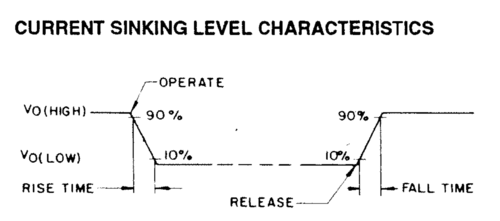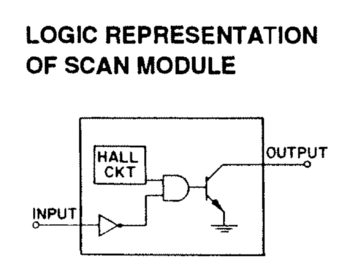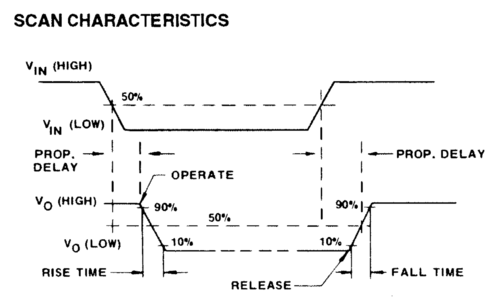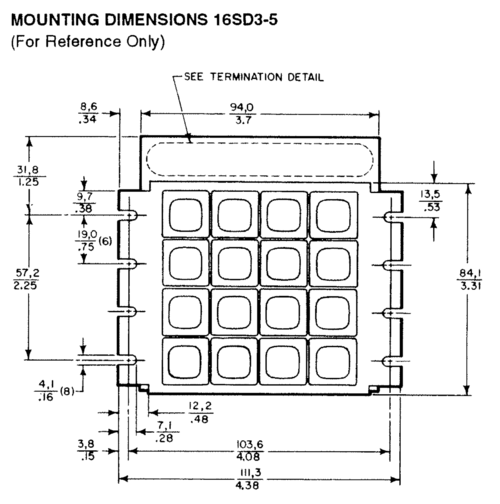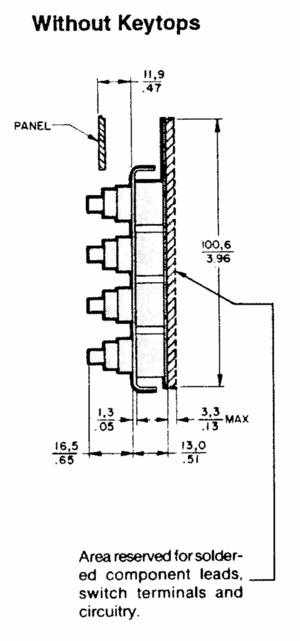Micro Switch SD Series
This article is a stub. You can help Deskthority by expanding it.
| Manufacturer | Honeywell |
|---|---|
| Inventor |
Everett A. Vorthmann Joeseph T. Maupin |
| Switch type | Linear, Tactile |
| Sense method | Hall effect |
| Rated lifetime |
Tested up to 30 billion (extremely long) |
| Peak force | 45 cN? to 320g |
Contents
History
Introduced in 1968, Micro Switch (a division of Honeywell) adapted their Hall effect switch technology to work in keyboards. These switches are among the highest quality ever produced by any keyboard switch company, with reliability being paramount to their design. For increased reliability, there are both 3 pin and 4 pin designs of the switch, the later with dual sense lines for redundancy. The patent itself originates from 1969, but the design is aesthetically very different from the produced switches.
The Honeywell Hall Effect switch is most famous on some Symbolics keyboards, as well as the Space-cadet keyboard.
Features (as per Honeywell)
Details for switch Model 4A3A which should be consistent across all models, except for operating force:
- Total Travel - 0.160 in (4.1 mm) nom.
- Force at operating point - 2.8 oz. (78 g) nom.
- Pretravel - 0.090 in. (2.3 mm) nom.
- Release point at 5 VDC and 75°F (24°C) (With respect to free position) - 0.040 in. (1.0 mm) min.
Keyfeel
Smooth linear switch, makes Cherry MX Black switches feel like they have sandpaper on the stems.
Keycaps



Honeywell Hall Effect keycaps are known to be exclusively double-shot, using very thick plastic in all cases.
Some keycaps have some odd properties such as this Caps Lock LED keycap (Switch Model 12B3S):
Availability
Honeywell hasn't been making these switches since the early 1990's and has been out of the keyboard business since then, so it's probably impossible to source them. Keyboards with the switches do show up occasionally on auction sites like Ebay, but this isn't always obvious, and they most certainly don't work with modern computers without a converter. The last known keyboard with these switches was made in mid 1996 for Sun Microsystems. Further research has shown that Honeywell has been using their "dual magnet" design to make backlit switches for industrial keyboards as recently as 1999. (Link)
Models


While the switch isn't in production anymore, there were many variants of the switch, with a specific naming scheme to the models.
In almost all standard variants of the switch, there is a spot for a LED add-on part as seen in the Convergent 64-00164 keyboard.
Naming Scheme
As a regular expression, the models can be shown as such (not yet confirmed from Honeywell datasheets): ([A-Z])?([0-9]+)([A-Z])([0-9])([A-Z])
- ([A-Z])? Sensor variant? (All sensor PCBs with this code have this printed on it)
- Q - ?
- R - ?
- T - ?
- ([0-9]+) Switch variant
- 1 - White stem
- 4 - Black stem
- 5 - Black stem, locking mechanism
- 6 - Short black stem
- 11 - Black stem, tactile
- 12 - LED keycap stem
- 16 - Alternate keyboard mount (Link)
- ([A-Z]) Stem type
- A - Straight stem
- B - Angled stem
- F - No keycap stem
- T - Angled stem, ridged housing
- ([0-9]) Switch weighting
- 1 - Light (45g?)
- 2 - Mid (55g?)
- 3 - Normal (78g)
- 5 - Heavier (120g?)
- 8 - Heavy (320g)
- ([A-Z]) Switch type
- A - 4 pins, 2 [redundant] sense lines (Unknown difference from K,S)
- D - Dummy (no pins)
- E - 3 pins, 1 sense line
- K - 4 pins, 2 [redundant] sense lines (Unknown difference from A,S)
- S - 4 pins, 2 [redundant] sense lines (Unknown difference from A,K)
Known Models
Confirmed variants of the switch:
- 1A3S - TI Telex 58SD17-2-B
- 1A8S - TI Telex 58SD17-2-B
- 1B3S - Nokia MikroMikko 1 keyboard
- 1F5A - UGC-74 Keyboard
- 4A1A - Honeywell 26SD1-2-H
- 4A1E - Burroughs TP110, Burroughs TP130
- T4A2B - Wang 271-1126 (Meaning of T is unknown)
- 4A2K - Wang 271-1126
- 4A3A - Bud Keypad 83959, Honeywell 26SD1-2-H
- Q4A3B - Wang 271-1126 (Meaning of Q is unknown)
- 4A3E - Burroughs TP110
- R4A3E - Burroughs TP130 (Meaning of the R is unknown)
- 4A8E - Burroughs TP110, Burroughs TP130
- 4B1D - Convergent 64-00164
- 4B1E - Space-cadet
- 4B1S - Convergent 64-00164
- 4B3E - Symbolics 3600 Rev D, Space-cadet
- 4B3K - Wang 271-1126
- 4B3S - Intergraph 2710
- 4T3S - Convergent 64-00164
- 5A3E - Burroughs TP110, Burroughs TP130
- 6A1D - Convergent 64-00164, Burroughs TP110, Burroughs TP130
- 6B1D - Convergent 64-00164, Space-cadet, Honeywell 26SD1-2-H
- 12B3S - Convergent 64-00164
- 16B3E - Sun 32SD38-4-E





